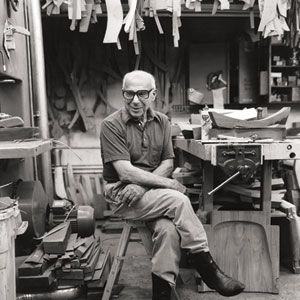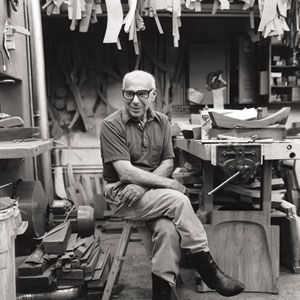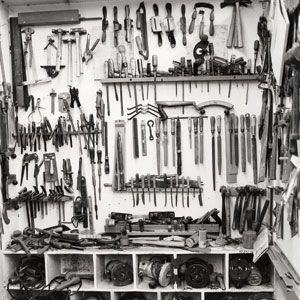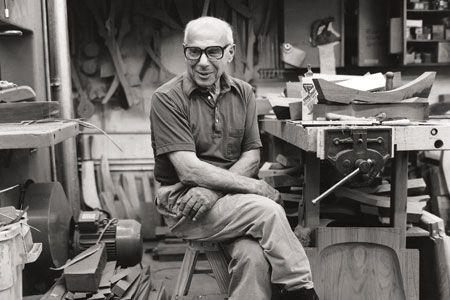
The September 2003 issue of This Old House magazine includes a column about rocking chairs and their creators, one of whom we’d had the pleasure of profiling several years ago. We thought our readers would enjoy this visit with the great Sam Maloof, so we’re reproducing it here in its entirety. This profile, which appeared in the March/April 1998 issue, was published before Freda Maloof’s death. Sam Maloof made a world. In a citrus grove now surrounded by malls and houses, in a wood shop where he hand-built furniture that is now revered as art, in the home he crafted one room at a time as he could afford the lumber and where he has lived the last half century, almost every minute of every day, with the wonder of his life — his wife, Alfreda — Sam Maloof made a world. He nurtured his lemons and oranges and figs, planted walnut and sycamore trees that started as cuttings the size of his thumb and eventually grew to engulf the grounds. He tore down a chicken coop and built a shop that always smells of sweet, fresh wood. He tore down a shack and built a house
that, like a piece of modern sculpture, has no front or back. In the kitchen, he laid bricks without mortar so that each step makes the music of wind chimes. Then he moved on to the living room, Freda’s study, the skylit tower, the guest room with a loft, the balcony overlooking the grove. The house ultimately came to 7,000 square feet — 26 rooms that unfold like a pyramid’s secret chambers adorned with handmade redwood doors, windows and jalousies, two dozen wooden door latches that resemble flying fish or bones or tusks, jagged-edged walnut dogboards nailed to the wall like abstract art, Douglas fir rafters with mortise-and-tenon joints at their peaks, window frames joined with dovetails, even toilet seats handmade from English oak and black walnut. Outside the grove, cars and trucks groan and spew and honk in stagnant air while, inside the grove, birds are always singing and a breeze is always rustling the trees. The question everyone wants answered is: Would Sam Maloof’s craftsman genius have blossomed if he had not first created this world in which to live and work? In other words, did his genius create this place, or did this place create his genius?
“Oh, I don’t know,” Sam says. “What do you think, Freda?”
Sam and Freda are puttering around their house in Alta Loma, California, at the foot of the San Gabriel Mountains. She is tidying the kitchen. He is giving a tour of the house and the 100 handmade chairs and tables, desks and settees, coffee tables, beds and dressers that decorate it, of the woodshop, of the 6 acres of lemons, peaches, pears, apricots, figs and avocados that sit like an island in a sprawling suburban sea. But this island, like Atlantis, is about to disappear forever, to be buried not underwater but under concrete, a new section of the nearby Foothill Freeway. Because Sam’s house and workshop are on the National Register of Historic Places, they will be moved to a scraggly citrus grove a few miles away and turned into a working museum. Sam will design and help build a new house on the new grounds for himself and Freda.
“It’s sort of scary sometimes,” Sam says of his success and fame, which have seemed almost to overtake him in recent years. His furniture is in the Metropolitan Museum of Art, the Smithsonian Institution’s Renwick Gallery, the White House and the homes of former presidents Jimmy Carter and Ronald Reagan. A dining room set he sold for $3,000 about 25 years ago resold recently for $150,000. One of his new high-backed rockers today sells for $18,000. “Sam’s furniture embodies intangible qualities that transcend the sensory delights of sight and touch,” Jonathan Fairbanks, curator of American decorative arts and sculpture at the Museum of Fine Arts in Boston, has written. Sam is hailed today not as a furniture maker but as an artist. Yet for all his success, Sam, at 82, is too militantly modest to take credit. And Freda, at 86, is too down-to-earth to think Sam — or anyone, for that matter — can deserve the world-renowned stature he has achieved.
“God’s been very good to us,” Freda says.
“I’d say I was lucky,” Sam says, “but I worked doggone hard.”
Freda flashes an ironic smile. “I didn’t know he was going to be so famous.” Sam is embarrassed. “Oh, Freda.”
“Freda helped me,” Sam says. Fifty years ago he was working as a graphic artist for a California company that made decals, but he wanted to quit and make furniture for a living. “She didn’t say, ‘You’re crazy. Just stay where you are. At least you’re making a living.’ She said, ‘If you want to do it, I think you should do it.'” After Sam lost money on his first commissioned pieces of furniture, he told Freda he was going back to graphics. She said, “No, you can do it.”
“You talk about faith, hope and charity,” Sam says. “She had it for me. I would have given up if it hadn’t been for Freda.”
“I was just happy he was doing something he loved,” Freda says.

Designing With Soul
As a young man, Sam Maloof could not afford power equipment, so he developed his woodworking skills using a few hand tools. A half century later, his shop is filled with an overwhelming array of electric routers and drills, squares, hammers, razor-sharp spoke shavers, rasps, files, pliers, calipers, screwdrivers and planes. opposite: Flanked by a band saw — the power tool he uses most often — and his workbench, Sam takes a rare break. People have described him as an artist, but he prefers to be known simply as a woodworker. “It’s an honest word,” he says. “And that’s what I am: a woodworker.”
Doing what Sam loved — creating about 50 pieces of furniture a year for 50 years — has made him one of the most respected craftsmen in the country. His chairs have the curving grace of a parabola, the embracing comfort of loving arms and the tactile sensuality of supple skin. They look and feel like living creatures, not pieces of wood connected by dowel and glue and joint, but single, seamless waves of wood. Sam once watched as the blind bluesman Ray Charles caressed a piece of his furniture and announced that it had “soul.” Sam likes that story because soul is a place beyond words, where hand, head and humanity blur.
“You can’t have soul without sincerity,” he says.
Sam and Freda are short and silver-haired. She is lithe and fragile and walks with an airy glide, her silky hair tucked up in a little twist. She speaks so softly that the last words of her sentences, like a distant sound trailing off, can be lost. She has a mild laugh, more like a sigh. And that ironic smile. Sam, on the other hand, is compact and muscular, nothing fragile about him. He walks with the spring of an athlete. He speaks slowly but with a deep voice that’s always audible. He looks a decade younger than his years, easy.
Freda has always kept Sam grounded. Early in his career, when art-show judges rejected two pieces of Sam’s work, he hang-dogged around the house looking for sympathy. “Sam,” Freda said, “rejection is good for the ego.” Decades later, when he won a $375,000 MacArthur Foundation “genius” grant, he was embarrassed at the ceremony that other winners’ resumes went on and on with various accomplishments and advanced degrees. His read, “Sam Maloof, Chino High School graduate, 1934, designer.” Freda just flashed her smile: “Sam, I bet there isn’t a person here who knows how to make a chair.” And when President Jimmy Carter and First Lady Rosalynn, who own several pieces of Sam’s furniture, stopped by the lemon grove one day, it was Freda who calmly asked the Carters to stay for dinner.
“She cooked chicken casserole,” Sam says.
Freda shrugs. “Well, that’s what we would have eaten.”
“And he,” Sam says of President Carter, “had two helpings.”
Freda believes Sam could write a book about the famous people he’s met.
“No,” says Sam, suddenly serious. “A memoir. How I met and married you.”
Now Freda is embarrassed. “Oh, Sam.”
The Maloof workshop connects to the house through an alcove off the living room. A giant fan sucks a cool breeze into the long, high-roofed building. Chairs are everywhere — half built, built, unsanded, sanded, unfinished, finished. Eight will go to a CEO in the Napa Valley. One will go to Singapore. Two to Atlanta. Each takes about a week of Sam’s cutting, shaping and gluing. Sam and three workers will then sand and finish them. Freda will send the bills and enter the sales in the books. Wooden templates marked with the names of the first people to buy each style of chair — Miller, Evans, Mars, Hafif — hang like stalactites from the ceiling. Hulking around the room are joiners, lathes, a planer, a band saw, a drill press, a shaper and a spindle sander. And holstered in a wooden rack along the wall are chisels — Sam’s favorite is 50 years old and has been sharpened down to a 1-inch nub.
“It’s like a favorite cup,” he says. “You get used to it.”
Sam still works 60 hours a week in the shop, down from the 80, 90 or 100 he worked as a younger man scratching out a living. Now almost every day, after he and Freda eat the lunch she has made, he takes a nap. Freda insists. She had not been well lately, and that worried Sam. Their son, Slimen, also a woodworker, had never seen his father so pensive and distracted, so unable to concentrate, as when Freda was sick.
“What’d the doctor say,” Sam asks Freda when she pokes her head into the workshop after returning from a morning checkup.
“I’m fine.”
“I’m sure glad you’re OK,” he says as Freda heads back into the house.
He is quiet for a moment, still looking worried about Freda. Finally, he goes on with his conversation. “The way people react to my furniture,” he says, “it’s almost embarrassing.” He gets letters by the hundreds — the woodworker who says meeting Sam briefly more than a decade ago changed his life, the composer who studies Sam’s furniture as inspiration for his music, the woman who says that, every time she looks closely at Sam’s chair in her living room, she cries at its beauty. Sam is human. He likes the respect that borders at times on adulation. But it baffles him.
“I went into woodworking thinking it would be a nice way of making a living,” he says. He wasn’t thinking about becoming famous or rich or making a chair that would be enshrined in the Smithsonian. He just couldn’t imagine commuting to an office cubicle. But now people study Sam to understand how the way he lives his life has fostered his creativity. He tells the curious that creativity is inherent in humans, God-given, although it can be either nurtured or suppressed. And blind determination matters.
Sam has known craftsmen who worked hard for short periods and found that no one would buy their furniture. Their feelings hurt, they quit. He has known woodworkers who believed they deserved recognition after making only a few pieces. He has known furniture makers who sold their designs to production companies, took the money and never built another piece. Sam believes that affirmation, glory and wealth are motivators that will do little to create a fine craftsman. He says, “You do it because of the love.”

An Organic Life
In his shop this morning, Sam is working for himself. Forty-five years ago, he made a chair for Freda’s mother, now dead. He has looked at that chair with his perfectionist eye for years, thinking the back is too small for its body and that he should fix it someday. Today is the day. He has taken a 2½-by-4-by-16-inch chunk of walnut in his hands and begun to sculpt it on the band saw, trimming away much of its thickness into a curving wave along what will be the new back of the chair. As he usually does, Sam stops what he’s doing to work on another chair for awhile, turning a leg on the lathe. Reddish walnut spalts mist his hair, eyebrows and arms.
“You have to feel it,” Sam says of the work. “You make a joint that fits absolutely perfectly, and you feel it. I still pinch myself. I’m not a workaholic. I just enjoy my work.” Never has Sam had a day when he woke up and didn’t feel the desire to work. “Sometimes the day is gone before I get started,” he says. He wonders: What if he had opened a workshop somewhere in an industrial zone, commuted there every morning, commuted home every night? Would he have made the furniture he did? He thinks not.
This world — this shop, this house, the grove, Freda, his daughter, who grew up here running in and out of the shop, his son, who became a woodworker in the grove, the men who have been with him for decades — this world created Sam as much as Sam created it. He is a meticulous man, who painstakingly laid the stones at his house’s entryway to look as if they were scattered at random. Everything here is as if Sam took a pencil and drew this world, then entered it. With stones laid, fig trees, olive cuttings and sycamore saplings carefully planted, woodwork covering nearly every square inch of the house. Like a poet who writes a line and then must respond to that now existing line in the next sentence, Sam was shaped by the world he shaped. His creativity, he believes, is rooted here in the grove, in the house, in the workshop.
Freda is back, standing at the door to the shop, waiting for the lathe to wind down.
“What’s up?” Sam says.
“Seth died yesterday afternoon.”
“Seth died?” He was a friend from their Methodist church.
“He died.”
“I saw him yesterday. He was fine.”
“He was in the garden, and he fell over dead.”
“Oh, my God! This is a sad thing.”
Sam goes back to turning, clearing his mind as he presses a gouge into the narrowing bottom of the chair leg. Spalts fly again. “That’s the way to go,” he says — in the garden, doing what you love. “People say, ‘Work must be the most important thing in your life,’ and I say, ‘But it isn’t. First comes God, then my family, my friends, my work, in that order.’ Without my family and friends, I would have no interest in work.”
That sentiment, beyond furniture, is really what has made Sam Maloof famous, as he and Freda have become a moral lesson on what so many people fear is missing in their lives. Sam and Freda left the bureaucratic, workaday world to live in a citrus grove beyond callous civilization. Sam never advertised. He once turned down an offer worth $22 million to mass-produce department-store versions of his furniture. People came to him by word of mouth, like disciples. He labored day and night in his work-sanctified shop, and they came to him. Life for Sam and Freda became like a piece of Sam’s furniture — organic and seamless: he and Freda walking the misty lemon grove before breakfast, she stopping by the shop on hot afternoons with lemonade, the two of them cooking dinner at night for raw-handed woodworkers, CEOs, even a President.
Life As Furniture
So what is the secret to creative work?
Sam tells this story: He once sent a friend’s son looking for a summer job to the famous Pennsylvania woodworker George Nakashima. The boy later called Sam and told him that Nakashima had hung up on him. Sam asked the boy what had been said.
Nakashima: “I couldn’t teach you to sweep my floors in three months.”
Boy: “I know how to sweep floors.”
The correct answer: “If it takes a year, I want to learn how to do it.”
“I would have hung up on him also,” Sam says. “There has to be a humility. Patience is very important.”
The men who work with Sam are master craftsmen, but sometimes for weeks they do nothing but sand spindles. “But they wouldn’t even think of doing a poor job because they were bored,” Sam says. “It isn’t because of how much I pay them. They do it for themselves. You have to work with integrity.” To be a fine craftsman, Sam believes, you must first be a good person. Somehow the qualities that make good people — humility, patience, integrity, sincerity — transfer to the objects they make. To Sam, that is a gift passed from God. After all, what is God if not goodness living in the hearts and minds and creations of people? Sam says he can teach anyone to be a good woodworker. But a person can’t be a fine woodworker without a good heart.
“You have to be able to see the beauty around you,” Sam says. Once he and Freda were walking through the woods, stopping to look at how a leaf was shaped or a stem held its flower. “And then Freda saw a little bird’s nest. It was abandoned. It was so beautiful. To see how a tiny bird could create and build such a beautiful nest is amazing to me. Life is discovery.” They took the nest home and still have it on a shelf. Each time Sam and Freda notice it, they are transported back to that day in the woods.
It will be hard for Sam and Freda to leave this made world. That bird’s nest, the flying-fish door latches, the dovetailed redwood window frames, the peaked Douglas fir rafters will all go with them. So, too, will the 100 pieces of Sam’s furniture — the chairs, tables, desks, settees, beds and dressers, the rosewood music stand Sam made for violist Jan Hlinka, who willed it back when he died. And, of course, the piece Freda is now touching gently with her fingertips, that smile on her face. “This is my rocking chair,” she says. “He gave it to me. It has my name on it.”
Made for Alfreda Maloof, Christmas, ’72. P.S. All my love.
“It all belongs to Freda,” Sam says.
But much will stay behind — the sycamore tree Sam planted as a sapling that is now a giant tree, the dry dirt that compresses under his boots on morning walks, the dust that rises with each step, the sunlight as it filters into Freda’s study. These pieces of Sam’s world can’t be moved. But he will not be depressed: “Freda and I have the chance to start life over again,” he says. Sam has plans. He will rejuvenate the scraggly citrus grove on his new land. He will plant walnut and maple saplings that will be giant in hope. He will build a Japanese teahouse over the land’s arroyo. And he will build a new house. “The house,” he says, “will be like a piece of furniture.”
Sam Maloof is again about to make a world. The question still: Will he create that place, or will that place create him?
“Well,” says Sam, “you can’t have one without the other.”
Where to Find It
Further reading
Autobiography:
Sam Maloof: Woodworker
1983, $50
Kodansha International
800-451-7556
Maloof home
Hand and Home: The Homes of American Craftsmen
by Tommy Simpson
1994, $50
Bulfinch Press
Chairmaking video
Sam Maloof: Woodworking Profile
Taunton Press
$19.95 plus $3 shipping
Taunton Direct
Box 5507
Newton, CT 06470
800-888-8286
Our thanks to:
Slimen Maloof
Larry White
Mike Johnson
Dave Wade.

